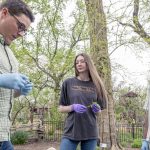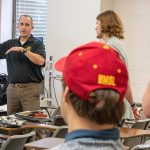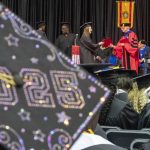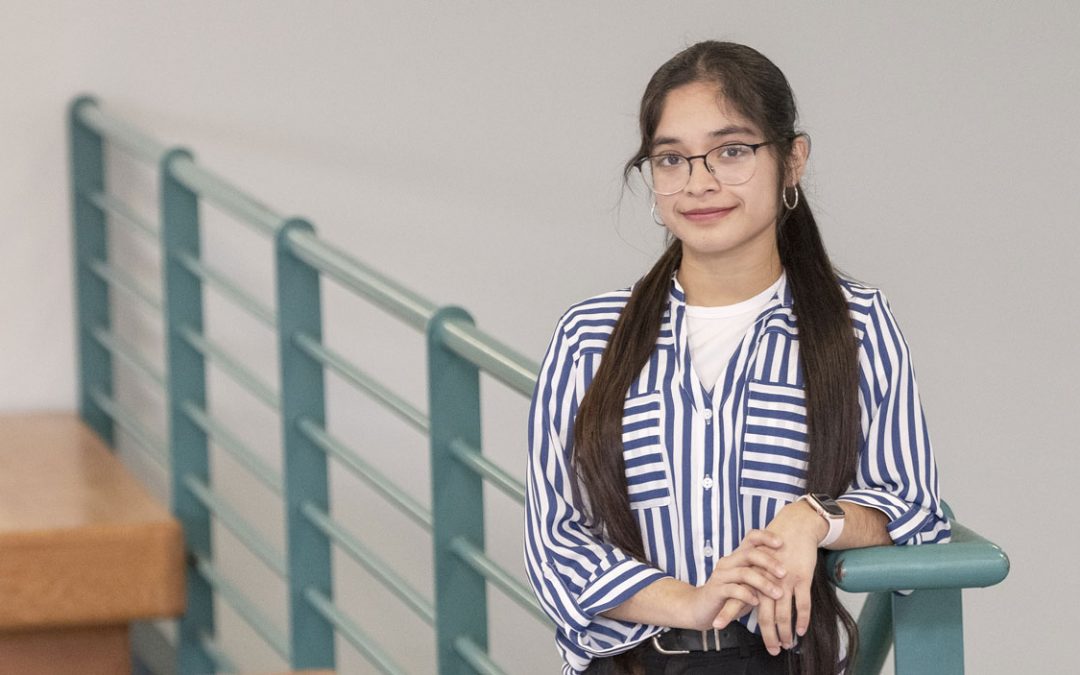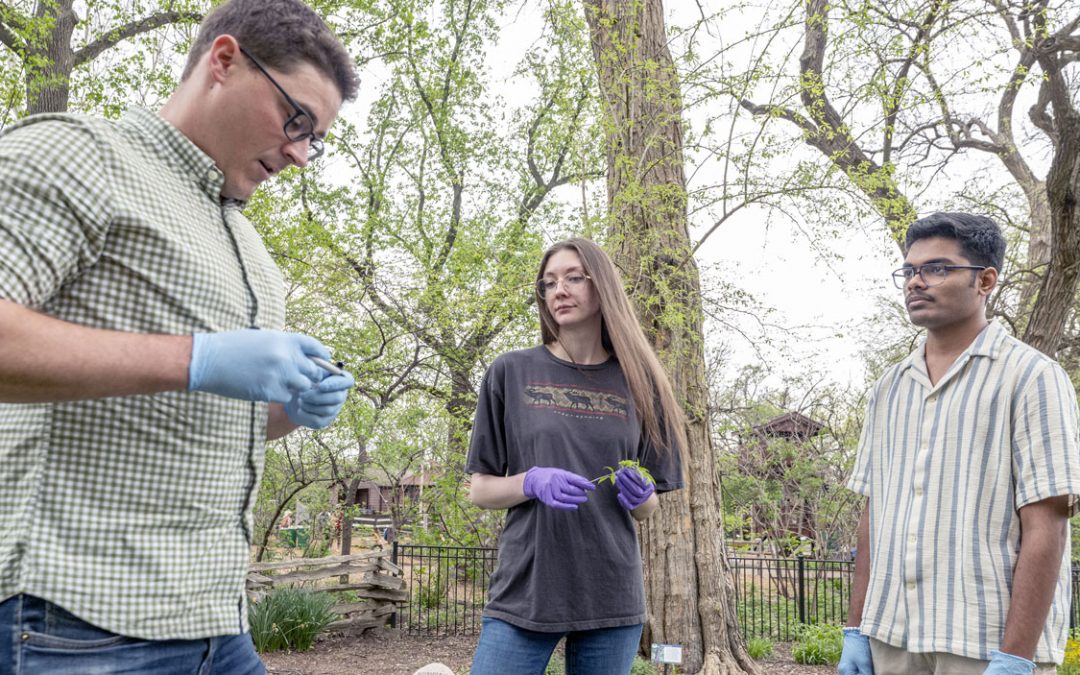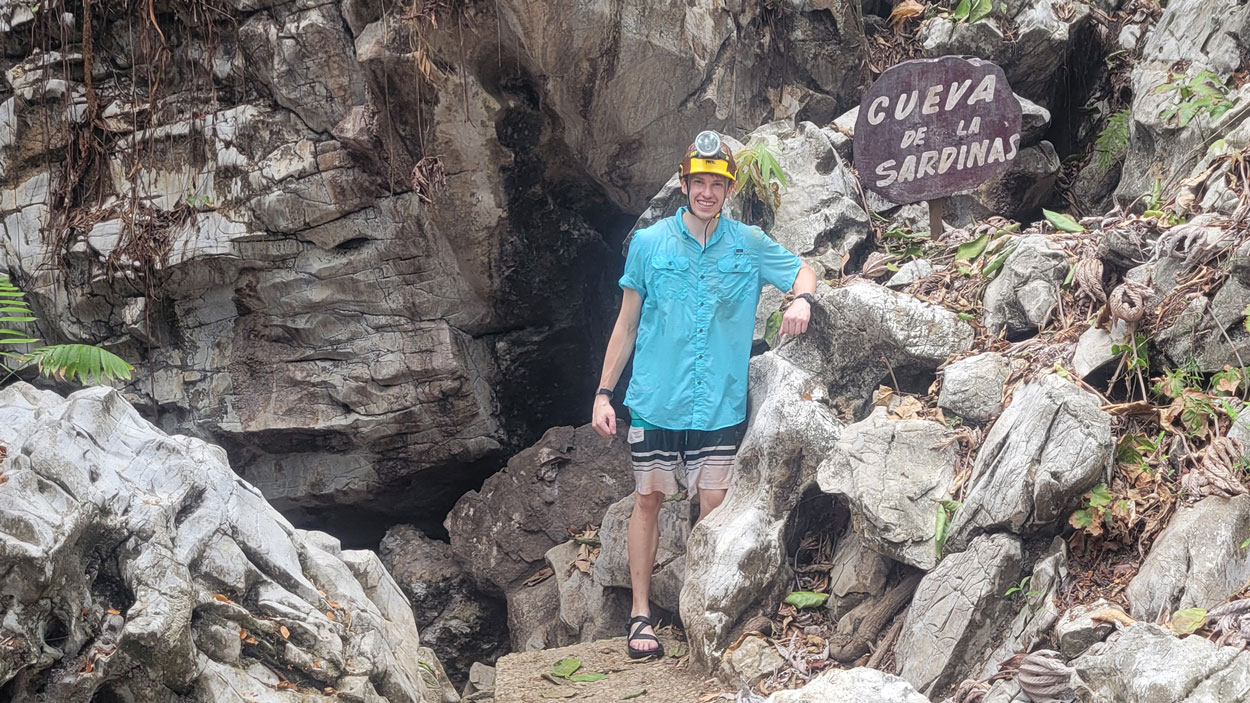
Biology doctoral student Soren Johnson stands outside the entrance to La Cueva de las Sardinas in southern Mexico. Johnson spent time last summer doing fieldwork in the cave and collected data on livebearer fish that call it home. (Photos courtesy of Soren Johnson)
Soren Johnson is always up for an adventure, so he was in his element last summer during a three-week stay in the state of Tabasco in southern Mexico.
Johnson, a third-year doctoral student pursuing his PhD in biology at the University of Missouri–St. Louis, was there doing fieldwork alongside Michi Tobler, the E. Desmond Lee Endowed Professor in Zoological Studies. He spent much of his time working inside La Cueva de las Sardinas – the Cave of the Sardines – donning a helmet, head lamp and respirator as he moved around, observing and collecting data on the tiny fish – known as cave mollies – that call it home.
“I really like the cave,” he said. “There’s hydrogen sulfide in the water, and that makes it smell bad. But the sulfide, when it oxidizes, also creates this really light blue coloration in the water. There are skylights, and some light will come in and hit it just right. That makes the cave look really beautiful.”
It’s an ideal setting to study genetic adaptations that occur in the fish – a type of livebearer from the family Poeciliidae with the scientific name Poecilia mexicana. Within a few hundred yards of each other, there are three distinct habitats – one deep in the cave that exists in near total darkness, one closer to the opening that is touched by patches of incoming light and one outside that receives sunlight throughout the day. The same species lives in all three areas but appears to have taken on different traits, notably the size of the eye, in each environment.
“It makes it a great system in which to better understand how the change in organisms happens,” Johnson said, “because of the environmental changes.”
Setting the course
Johnson grew up in the town of Wheaton in northeastern Illinois. He had a love of the outdoors and was fascinated by animals – an interest cultivated by his mother and his grandfather, a former high school biology teacher.
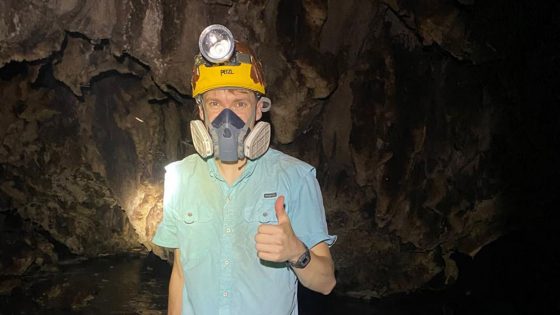
The presence of hydrogen sulfide in the water gives a foul odor to Las Cueva de las Sardinas, so Soren Johnson wears a respirator and helmet while working in the cave.
But he never imagined where it might lead him as he chose to study the natural world.
“I knew I really wanted to do something working with animals, and I started asking questions and trying to figure out the answers,” Johnson said. “That led me to wanting to do research.”
After high school, he decided to study zoology at Olivet Nazarene University in Bourbonnais, Illinois, about 60 miles south of Chicago. He learned from Professor Leo Finkenbinder and gained some early research insight working with Professor Derek Rosenberger.
By the time Johnson graduated, he knew he would be pursuing a graduate degree and studying genetic changes in animals, but he put off that next step so he could gain some more real-world experience. He took a job as a fisheries technician with the Illinois Natural History Survey and spent more than a year and a half stationed at the Lake Michigan Biological Station in Zion, Illinois, just south of the Wisconsin border.
During the summer, Johnson spent most of his time in the field, interviewing people fishing in the lake and gathering data about what they were catching. He also collected environmental data and took samples of invertebrates living in the sediment at the bottom of the lake and zooplankton and fish living within the water column. When the weather turned cooler, he bided his time in the lab, analyzing the information and samples he collected to monitor the health of the ecosystem.
“That was my first major introduction into working with fish,” Johnson said. “I got more interested in them as I realized the high level of diversity in fish, which most people don’t usually see.”
Meeting his mentor
When it came time to begin graduate school, Johnson enrolled in a master’s degree program at Southeastern Louisiana University, drawn to the chance to work with ichthyologist Kyle Piller, who was researching the phylogeny and population genetics of a species of minnow called the black tail shiner. In two years working in Piller’s lab, Johnson found himself captivated by the wide variation in forms he saw as he encountered fish living in different environments.
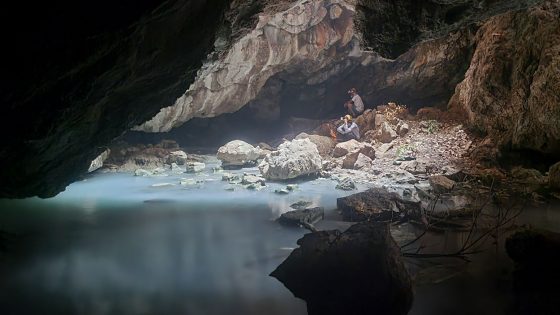
The hydrogen sulfide in the water in La Cueva de las Sardinas oxidizes and creates a light blue coloration.
But the most significant thing he might’ve taken away from the experience was the introduction Piller helped him make to Tobler, then a faculty member at Kansas State University, as he began investigating doctoral programs.
Tobler studies fish living in extreme environments with much of his work over the past 20 years focused on the hydrogen-sulfide-rich springs in and around La Cueva de las Sardinas.
“A lot of my master’s was focused on phylogeny and population genetics, and I liked doing that work, but I also wanted to broaden it and get experience in other things,” he said. “I was looking for different places to go, and my advisor knew Michi decently well. He was telling me that Michi was looking for students, and I saw he was doing lots of cool research on extreme environments. I thought that was really interesting, and I thought that would give me the opportunity to expand on some of the things I’d already learned.”
Johnson reached out to Tobler to inquire about joining his lab, and the two clicked during their initial conversation.
“He seemed like someone who really cared about grad students and their success,” Johnson said.
Johnson quickly moved to the top of the applicant pool and received a GAANN (Graduate Assistance in Areas of National Need) Fellowship when he enrolled at Kansas State to begin working toward his PhD in August 2022.
He had settled into the program and was getting set to begin fieldwork for the first time in southern Mexico when Tobler broke the news late in the spring of 2023 that he was leaving Kansas State for the Des Lee position at UMSL.
Tobler gave all his students the option of continuing their studies and research at Kansas State or following him to St. Louis. Several students opted to remain in Manhattan, Kansas, because they were close to completing their degrees, but Johnson barely hesitated to make the move.
“I didn’t choose Kansas State because of Kansas State, I chose it more because I wanted to do work with Michi,” he said. “It was a pretty easy decision, but there was some difficulty having to start again in a new place and learn the ropes of a new university.”
Making a new home
If Johnson had an adjustment coming to St. Louis, there’s little doubt he made Tobler’s transition easier. He helped Tobler build out space on the first floor of the Research Building with tanks to hold the hundreds of fish they maintain for their research so that the lab could resume its activities.
“Obviously our interests mesh really well, so I’m glad he came along,” Tobler said. “It helped us really hit the ground running here at UMSL to have people like Soren that already worked with me, that could help build up our facilities. He deserves a lot of credit for making those things happen.”
Johnson has never been drawn to large cities, but he’s found St. Louis very easy to maneuver, and he’s gotten involved on the UMSL campus, competing in intramural sports and joining the Biology Graduate Student Association. He currently serves as the organization’s president.
Most of his time is still divided between coursework, tending to his responsibilities as a teaching assistant in the Department of Biology and his research.
In addition to his work with the fish in La Cueva de las Sardinas, Johnson has also been part of a project Tobler launched with research groups at the University of Minnesota and Lehigh University to study the evolution of Mexican tetra, sometimes called the blind cave fish (Astyanax mexicanus), that are found in caves and surface springs throughout eastern Mexico and into parts of Texas. They received a grant from the National Science Foundation for the work, which has centered on a cave located in the state of San Luis Potosi in northeastern Mexico.
“We’re working together to see if we see similar patterns between the two different species in how the fish live in the cave and their evolution to the cave environment,” Johnson said.
Tobler’s lab is adding light and dark rooms on the third floor of the Research Building where they’ll house Mexican tetra and will be able to run experiments simulating cave environments.
Last May, Johnson’s research got an unexpected boost when the Society for the Study of Evolution selected him as one of 21 recipients of the 2024 R. C. Lewontin Early Award. The honor comes with up to $2,500 in funding to support research for PhD students in their first or second year.
“It made me super happy to see Soren get that,” Tobler said. “Those awards are super competitive, and it really means something to have that on your CV as an evolutionary biologist.”
Johnson is on track to finish his coursework next fall and begin working on his dissertation. He anticipates graduating in the spring of 2027.





